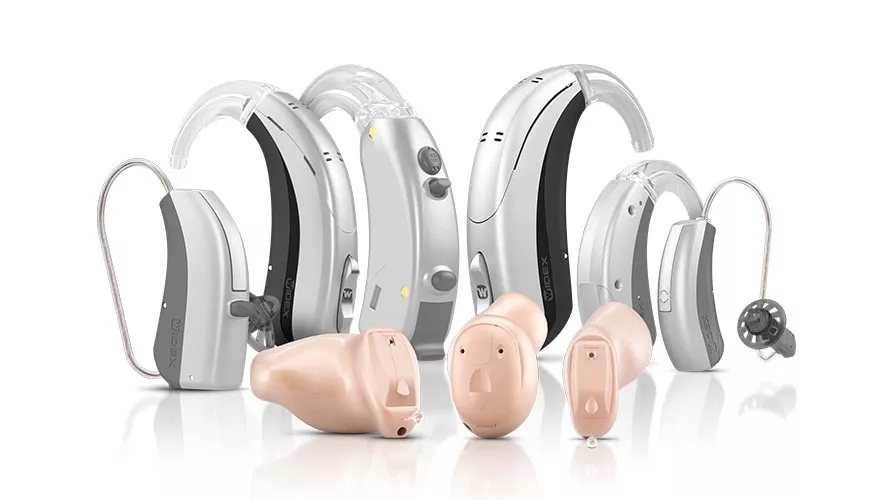What is a hearing aid? What types of hearing aids are there?
Hearing aids are amplification devices that help people with hearing loss to improve their hearing and improve their speech and communication skills. There are several types of hearing aids such as cassette, spectacle, behind-the-ear, in-the-ear and canal hearing aids, among which in-the-ear hearing aids are the most widely used. Completely in-canal hearing aid: It is the smallest hearing aid that is placed in the deep ear canal and is completely unnoticeable, which is called “hidden hearing aid”.
When should I wear hearing aids?
Both adults and infants should be fitted with hearing aids when their average hearing loss is ≥40dB, and their hearing cannot be improved by medication, surgery and other treatments, and they are diagnosed by doctors as having irreversible hearing loss.
Who is a good candidate for hearing aids?
Anyone with deafness of any nature who wishes to improve their ability to communicate verbally can be a candidate for hearing aids. In general, people with moderate hearing loss benefit the most from hearing aids.
What are the benefits of wearing hearing aids?
The purpose of choosing hearing aids is not only to maximize speech comprehension, but also to improve the quality of life and social skills of the patient. The development of speech and perception in children relies on the auditory signals they receive, and hearing impairment in infants and children without timely intervention is bound to cause speech impairment. Hearing impairment can reduce their educational opportunities, employment scope and job opportunities, and affect their employment promotion, so wearing hearing aids is especially important; and for elderly patients, through scientific hearing aids, they can improve their hearing, improve their quality of life, and avoid isolation, dementia and psychological diseases.
Can I just buy and wear a hearing aid?
Hearing aids must be fitted by professionals after a comprehensive analysis of the condition and hearing. If the hearing aid is not suitable for the patient, he or she will feel poor and uncomfortable, and the remaining hearing will be damaged. This can lead to reluctance to wear them and loss of optimal treatment time. In addition, after wearing the hearing aid, you need to communicate with the professionals and debug the hearing aid, so that you can achieve the ideal treatment effect.
Why is binaural fitting recommended?
Binaural fitting is recommended for anyone with hearing loss in both ears and no contraindications to binaural fitting.
❶ binaural fitting improves the integration effect of sound collection, noise reduction, and balance in the ear itself, and improves listening comfort.
❷ binaural fitting improves the ability to localize sound sources and improve speech discrimination.
❸ A patient with bilateral hearing impairment who chooses to wear only one hearing aid. The ability of the auditory center in the ear without a hearing aid to understand language will gradually decline, a phenomenon known in audiology as progressive (delayed) auditory deprivation, which becomes more severe the longer it takes. The most effective solution to avoid this phenomenon is to have hearing aids in both ears at the same time.
❹ Wearing hearing aids in both ears allows the overall gain of each hearing aid to be slightly reduced, thus reducing the likelihood of acoustic feedback and improving battery life.
❺ Allowing each patient with bilateral hearing loss to be in a normal audible state in both ears, the acoustic stimulation causes excitation of the auditory nerve and delays the decline of auditory nerve function.
How to use hearing aids correctly?
There are 3 major principles to be noted in the use of hearing aids: moisture-proof, shock-proof, and earwax-proof. Dampness can easily cause the components inside the hearing aid to rust and malfunction, so it is necessary to put the hearing aid into the dry box every day to absorb moisture. It is best to use cotton swabs to clean the ear canal every day, and if there is too much ear wax, you need to go to the hospital for cleaning.
More articles about hearing aid information.
EIGHT BENEFITS OF RECHARGEABLE HEARING AIDS
FREQUENTLY ASKED QUESTIONS ABOUT RIC-STYLE HEARING AIDS
WHY DOES MY HEARING AID CRACKLE?
WHAT YOU NEED TO KNOW ABOUT THE BENEFITS OF RIC MINI HEARING AIDS
IS HEARING THE SAME AS NORMAL WITH HEARING AIDS?
Post time: Sep-18-2021
